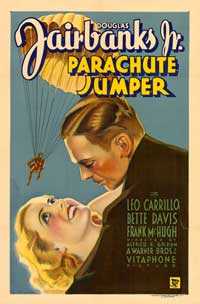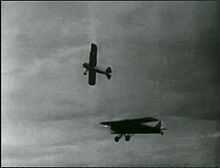Parachute Jumper
| Parachute Jumper | |
|---|---|
 Theatrical release poster | |
| Directed by | Alfred E. Green |
| Produced by | Darryl F. Zanuck (uncredited) |
| Written by |
Rian James (story) John Francis Larkin |
| Starring |
Douglas Fairbanks, Jr. Bette Davis Frank McHugh |
| Music by | Leo F. Forbstein (Orchestra conductor) |
| Cinematography | James Van Trees |
| Edited by | Ray Curtis |
| Distributed by | Warner Bros. |
Release dates |
|
Running time | 65 minutes (also listed as 70 and 73 minutes) |
| Country | United States |
| Language | English |
Parachute Jumper is a 1933 Pre-Code black-and-white drama film starring Douglas Fairbanks, Jr., Bette Davis and Frank McHugh. It was based on a story by Rian James entitled "Some Call It Love".
Plot
United States Marine Corps Lieutenants and pilots Bill Keller (Douglas Fairbanks, Jr.) and "Toodles" Cooper (Frank McHugh) are shot down in the skies over Nicaragua. When they are found drunk and unharmed in a cantina, they and the Marine Corps go their separate ways. They are offered jobs as commercial pilots, but when they arrive in New York City, they find their would-be employer has gone bankrupt.
Unemployed and almost out of money, they meet blonde Southerner Patricia "Alabama" Kent (Bette Davis). Keller convinces her to share their apartment to save on expenses.
Keller narrowly escapes death when he parachute jumps for some money. Next, he becomes the chauffeur for Mrs. Newberry (Claire Dodd), the mistress of gangster Kurt Weber (Leo Carrillo). She makes it clear that she expects more than just being driven around by him. Weber comes in and finds Mrs. Newberry kissing Keller. He kicks her out, but is impressed by the cool way Keller handles himself when threatened with a gun. Weber hires him as his bodyguard. By chance, Alabama gets hired by Weber as a secretary.
Later, Keller and Cooper become entangled in Weber's smuggling schemes, flying in contraband from Canada. On the return trip, Keller shoots down two airplanes who intercept and fire upon him, thinking they are hijackers when they are really part of the Border Patrol. Fortunately, there are no fatalities.
Weber and his henchman Steve Donovan (Harold Huber) set a trap for two disgruntled, unpaid ex-employees; Donovan guns them down in cold blood, intending to frame Keller, but Alabama overhears and calls Keller away from the scene. As a result, Keller hands in his resignation, but Weber persuades him and Cooper to make one more delivery for him. After Cooper leaves, Keller learns that they have been smuggling not liquor, but narcotics. The authorities close in on Weber's office; Weber and Keller get away, but Weber leaves Donovan behind to get shot down.
Weber has Keller fly him away. The Border Patrol catches up and shoots them down. Keller has time to arrange it to look like Weber was the pilot and he was a kidnap victim.
Unable to find work, Cooper decides to rejoin the Marines. Keller finally finds Alabama and asks her to marry him, saying that he can support her if he too reenlists in the Corps.
Cast
As appearing in screen credits (main roles identified):[1]
- Douglas Fairbanks, Jr. as Bill Keller
- Bette Davis as Patricia "Alabama" Kent
- Frank McHugh as "Toodles" Cooper
- Claire Dodd as Mrs. Newberry
- Leo Carrillo as Kurt Weber
- Harold Huber as Steve Donovan
- Thomas E. Jackson as Detective Lt. Coffey

Production
Of the many films she had made, Bette Davis rated Parachute Jumper "dead last". More than problems with the screenplay, she saw her character as another in a long line of insignificant roles that were not furthering her career, and complained strenuously to Jack Warner.[2]
With aviation as the theme, Hollywood movie pilot Paul Mantz was successful in obtaining the contract to provide the flying sequences.[3] The aircraft used were the Buhl CA-6 Airsedan, Curtiss Fledgling, Fairchild 71 and Stearman C3R.[4]
Reception
Mordaunt Hall, reviewer for The New York Times, called it "a fast-moving tale of adventure in the air and on earth ..."[5] That review summed up the format of crime and adventure in the air that had been explored in a number of other films of the period.[6] In a later review, Leonard Maltin called it a "Fast-moving, enjoyable Warner Bros. programmer."[7]
In popular culture
Clips of Parachute Jumper are featured in the prologue of the first film version of What Ever Happened to Baby Jane? (1962) as an example of the supposedly poor quality of the film work of Jane Hudson (Bette Davis) as an adult.[2]
References
Notes
- ↑ "Parachute Jumper (1933): Full credits." IMDb. Retrieved: August 15, 2013.
- ↑ 2.0 2.1 Carr, Jay. "Articles: Parachute Jumper (1933)." Turner Classic Movies. Retrieved: August 15, 2013.
- ↑ Wynne 1984, p. 138.
- ↑ "Parachute Jumper". Aerofiles. Retrieved: August 15, 2013.
- ↑ Hall, Mourdant. "Parachute Jumper (1933); Douglas Fairbanks Jr. and Frank McHugh teamed in a story of adventures in air and on earth." The New York Times, January 26, 1933.
- ↑ Farmer 1984, p. 30.
- ↑ "Leonard Maltin Movie Review: Parachute Jumper." Turner Classic Movies. Retrieved: August 21, 2013.
Bibliography
- Farmer, James H. Broken Wings: Hollywood's Air Crashes. Missoula, Montana: Pictorial Histories Pub Co., 1984. ISBN 978-9-999926-515.
- Wynne, Hugh. The Motion Picture Stunt Pilots & Hollywood's Classic Aviation Movies. Missoula, Montana: Pictorial Histories Publishing, 1987. ISBN 0-933126-85-9.
External links
- Parachute Jumper at the Internet Movie Database
- Parachute Jumper at the TCM Movie Database
- Parachute Jumper at AllMovie